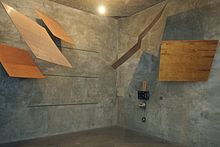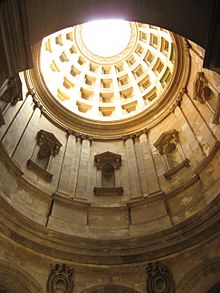
Back প্রতিধ্বনি প্রকোষ্ঠ Bengali/Bangla Páskové echo Czech Hallraum German Chambre d'écho French חלל תהודה HE エコー・チェンバー Japanese Екот Macedonian Galmkamer Dutch
This article needs additional citations for verification. (January 2024) |


An echo chamber is a hollow enclosure used to produce reverberation, usually for recording purposes. A traditional echo chamber is covered in highly acoustically reflective surfaces. By using directional microphones pointed away from the speakers, echo capture is maximized. Some portions of the room can be moved to vary the room's decay time. Nowadays, effects units are more widely used to create such effects,[1] but echo chambers are still used today, such as the famous echo chambers at Capitol Studios.[2]
In music, the use of acoustic echo and reverberation effects has taken many forms and dates back many hundreds of years. Sacred music of the Medieval and Renaissance periods relied heavily on the composers' extensive understanding and use of the complex natural reverberation and echoes inside churches and cathedrals. This early acoustical knowledge informed the design of opera houses and concert halls in the 17th, 18th, and 19th centuries. Architects designed these to create internal reflections that would enhance and project sound from the stage in the days before electrical amplification. Sometimes echo effects are the unintentional side effect of the architectural or engineering design, such as for the Hamilton Mausoleum in Scotland, which has one of the longest reverberation times of any building.[citation needed]
- ^ Huber, David Miles; Runstein, Robert E. (2005). Modern recording techniques (6th ed.). Burlington (Mass.): Focal. p. 108. ISBN 978-0-240-80625-9.
- ^ Seetoo, John. "A Visit to Capitol Studios". PS Audio. PS Audio. Retrieved 7 October 2021.
© MMXXIII Rich X Search. We shall prevail. All rights reserved. Rich X Search